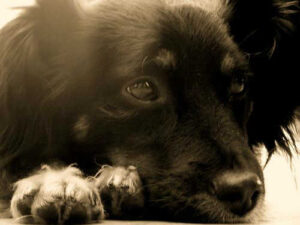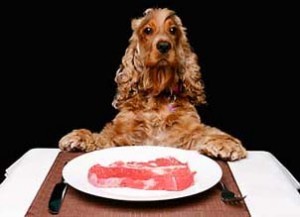What is Healthy Dog Food and Which Option Is Best?
 Healthy dog food is little understood by dog owners and vets alike. Usually the conversation revolves around healthy dog food brands while the question of what actually is healthy dog food goes un-answered.
Healthy dog food is little understood by dog owners and vets alike. Usually the conversation revolves around healthy dog food brands while the question of what actually is healthy dog food goes un-answered.
Isn’t Kibble Supposed To Be 100% Complete and Balanced?
The only reason this statement is splashed across bags of dry pet food is because synthetic vitamins and minerals were added as part of the processing requirement to meet minimum theoretical pet food standards as set out by AFFCO. Synthetic vitamins and minerals aren’t well absorbed by your dog’s body and can lead to long-term ill health.
Add the same vitamins and minerals to Oreo cookies, for example, and they would be concidered complete and balanced nutritionally.
Would you be satisfied with eating Oreo cookies at every meal?
We grow up watching cute dog commercials on the TV. We also casually take in pet food advertising plastered about the human landscape. And we naturally assume that the little pieces of oily salty crunchy kibble bits in boxes and bags, or the smelly stinky mushy stuff covered in jelly, that we carefully avoid getting on our hands as we scoop it out of the can, is what dogs and cats eat.
The Radical Alternative Shunned By 99% of Vets
You’ve heard the term, raw food diet for dogs. The radical alternative voiced by advocates of raw diet supporters who believe that dogs should eat natural healthy dog food in it’s raw untouched state. This is much like what we buy at the butchers or supermarket cold section and cook for our dinner but for our dog to eat, it should remain raw. Today it’s gained widespread acceptance from pet parents fed up with pills, antibiotics, steroids, creams and those wickedly convenient drugs, Tramadol, Prednisone and Metacam. After all, convenience has it’s price.
What’s a Pet Parent to Believe Any More?
The first thing to take into account is the ability of food to either be good for a dog or bad for them. Food cannot be neutral.
The second thing to note is how appropriate the food is for a given species, in this case dogs, because they are broardly a carnivorous animal according to the Merriam-Webster Dictionary.
The General Dietary Needs of Dogs
- High moisture content to prevent organ dysfunction, dehydration and renal failure. 70% on average in any given food for dogs needs.
- High quality protein content in line with natural carnivore needs.
- Balanced diet that includes naturally occurring vitamins, minerals and other bio available nutrients.
With this in mind, here’s a run down of the foods available for dogs and their relative nutritional adequacy.
Best to Worst Diets to Feed Dogs – The Options
1-Balanced Homemade diet of raw food-is as about as good as it gets for your dog or cat. Because it’s their natural  species appropriate diet most biologically aligned to their digestive system. Dogs and cats literally thrive on a well balanced raw food diet. The food is unadulterated, contains live enzymes, flavonoids, fatty acids, naturally occurring vitamins and minerals and a host of nutrients that are otherwise destroyed by heat and processing in commercial pet foods.
species appropriate diet most biologically aligned to their digestive system. Dogs and cats literally thrive on a well balanced raw food diet. The food is unadulterated, contains live enzymes, flavonoids, fatty acids, naturally occurring vitamins and minerals and a host of nutrients that are otherwise destroyed by heat and processing in commercial pet foods.
The dog or cat owner has complete control over the diet and can with the right information include plenty of nutritional variety to bring about balance.
2-Commercial grade raw food–is second and today it’s becoming widely available in frozen pre-packaged form ready to open and serve, much like it’s dry and canned commercial dog food counterpart.
It’s important to buy a good cross section of these prepared foods so you can achieve an acceptable nutritional balance.
The internet is still the best place to find a good supply of different raw foods needed to balance the diet although many small boutique pet shops in cities are now offering freezer section choices to cover your needs.
3- Freeze-dried raw food. It’s as convenient as kibble but more expensive. The advantage over kibble is that this option retains much of it’s nutrative content, taste and doesn’t need refrigeration.
4-Homemade diet of cooked food-is third and still the favorite of many dog and cat owners. The fact that the food is cooked does destroy many nutrients thereby diminishing its quality. However, as with the UK’s oldest dog at age 22 fed a healthy homemade dog food diet its whole life, there is still viability to this diets nutrient profile.
5-Human grade food in cans-is fourth as the food contained in the can and stated on the label is of human grade. Generally this food is expensive and on par with commercially available raw food in terms of cost.
6-Commercial premium canned food-is fifth and widely available through major supermarkets. Although of better quality than the white label or own brand offerings, the practice of “co-labeling” often means the same contents in both expensive and cheaper options are exactly the same contents having been produced on the same production line but with different labeling.
7-Veterinary endorsed canned food-is sixth and purchased through your local veterinary practice. Science Diet is the major choice here. Again, the lines can be blurred with the practice of co-labeling but generally it’s thought to be of better quality than what comes next.
8-Human grade dry food in boxes and packets-is seventh and contains ingredients suitable for humans. However the moisture content is low at around 12% and does not meet basic nutritional adequacy for dogs or cats.
the moisture content is low at around 12% and does not meet basic nutritional adequacy for dogs or cats.
9-Veterinary endorsed dry food-is eight and although your vet is behind it, he or she’s selling it for profit so ethics aside the nutritional quality is average at best and sub optimal for your dog or cats health.
10-Commercial premium dry food-is ninth and contains ingredients of highly questionable origin, low moisture content, as many as 29 different additives and of low nutritional value to dogs and cats.
11-Deli store no name brand dog and cat food-is tenth and to be avoided at all cost. In all honesty it’s probably not that much worse than the premium brand labeled cans. But one thing you can be sure of, it’s unsuitable for optimal nutrition for dogs and cats.
12-Deli store no name brand dry food-is eleventh and because it’s low in moisture, of questionable origin and filled with additives, it’s to be avoided.
13-Semi moist food in pouches (including moist treats)-is twelfth and this one is dangerous to pets period as it is kept in this semi moist condition with propylene glycol. This preservative is banned in human food and destructive to dogs and cats health.
Where’s the cut off point in this list?
 Having spent years researching the commercial pet food industry and read every book out there on the subject of pet nutrition, I can say that below No. 4 you’re going to struggle for reasonable balanced nutrition for your dog or cat.
Having spent years researching the commercial pet food industry and read every book out there on the subject of pet nutrition, I can say that below No. 4 you’re going to struggle for reasonable balanced nutrition for your dog or cat.
There are NO laws to keep commercial pet food manufacturers in check. The AFFCO guide lines set up to offer some consumer protection from malpractice are inadequate at best and at worst, cause the death of millions of pets annually, simply by allowing pet food manufacturers to self regulate.
Why Co-Labeling Confuses Things Further
With the practice of running different pet food brands on some Chinese production lines and simply labeling up the cans with premium and no name brand labels, we cannot be sure of what we are getting. The labels nutrition section is mostly a work of fiction, as again, the pet food manufacturers do not have to come clean on exact contents.
With the addition of potentially 29 different synthetic additives, to produce colors, preservation, smell, taste, palatability and so on, you can be sure, that you will never know what’s in that can or packet.
9 Out Of 10 Dog Health Problems Result From Diet
If you do have health problems with your pet, you can be pretty sure it’s because of the diet he or she is consuming.
As the world goes forward from here with deteriorating economic conditions, commercial pet food will only become more variable in quality with cheaper, less appropriate and harmful ingredients.
My recommendation for a good healthy dog food is to feed your pet a homemade raw food diet, a commercial raw food diet or a freeze-dried raw food and last, a home cooked food diet.
Your Decision Priorities – Economy, Convenience or Nutrition?
Your three main concerns when out buying your dogs dinner are your budget, how convenient you want the diet to be and how much nutrition the food gives your dog. I’ll agrre, you can’t optimize all three, so there has to be a compromize. If you have a small dog, your options are going to be different than if you have a couple of German Shepheards.
The Choice Is Yours..
Commercial pet foods, regardless of the marketing messages about wild ingredients or human grade quality, if it has been cooked, preserved and put in a can or packet, it’s not biologically appropriate for your dog. You can pay premium prices for clever marketing and fancy labels but the contents will aways be sub-optimal nutritional quality.
If nutrition is your priority, learn more about making your own homemade raw food diet for dogs —>Click Here.
If economy, but with an eye to boosting nutrition is a priority – especially with niggly health complaints, you’ll want to improve your dogs regular kibble diet to be much healthier. I highly recommend you take a look at my Ebook – Feed Your Dog Better which includes the Healthier Kibble Diet.
The book also includes the complete Home Cooked and Raw Food Diets.
If your priority is simply convenience but you have the budget, then give raw freeze-dried a go.
Question: What’s your opinion on pet foods? Please comment below.




I FEED MY ENGLISH BULLDOG WELLNESS SIMPLE SOLUTIONS KIBBLE, ORGANIC PUMPKIN, GREEN BEANS, ORGANIC PLAIN NON-FAT UNSWEETENED YOGURT AND BLUE BERRIES, IS THAT OKAY?
Hi Linda, to be honest with you, no it’s not okay. Why? Because a dogs primary need is for raw meat and bone and other foods are secondary. Kibble is the extruded (cookie cutter) result of food that’s been highly processed which means it’s not optimal nutrition for your Bully. So consider feeding a raw food diet or second best, a home cooked diet otherwise go for human grade canned food with minimal natural additives which is better than kibble.
The other foods you mention are ok in small amounts.
I just started feeding my dog raw food. I started with chicken for the first week and she is fine. On the second week, I gave her sirloin steak and she vomited so I gave her back the chicken. I tried to give her the extra sirloin the next day and she did vomit again. Does this mean she is allergic to red meat? What other red meat can I give her?
Thank you
Hi Irene, she may not be ready for it or simply dislikes it, or found that rich meaty steak without much bone content is too much too soon.
I’d move onto lamb breast which containes more rubbery bones between the meat for a better balance.
I guess the theory behind biologically appropriate raw food is that your pet should be fed on raw meat and bones as their wild ancestors (wolves) would have done. It seems as if these diets tend to contain the feeding of raw chicken wings, necks or carcasses with bones. In addition the weekly feeding of fish is also recommended. No winder Raw diet proponents point to the wolf as a comparison.
It is amazing how consumers have been programmed to think that packaged dog food is healthy and that it contributes to a long life of a dog. I recall one commercial that claims most vets choose this brand over other brands. I don’t want to name any brand names, but there is one brand that claims to be the choice brand. In these pet food commercials, you always see a full breed puppy to touch the heart of dog lovers.
Hi Jose, I know exactly the brand you are talking about and it’s got most dog owners fooled when in truth it’s far from adequate dog nutrition. The adverts go for maximum emotional impact year in year out and have most dog owners today thinking that dog food comes in cans and packets!
Hi Lacey, yes generally we work on the diet of wild dogs, add in some of the missing components and formulate recipes which fulfill the nutritional requrements of our dogs. The result is great health and wellbeing. One look at our raw fed dogs demeanor makes this incredibly satisfying to be part of.
I want my dogs to live as long as they possibly can healthily so if I can make their food and have them be healthier and live longer that is what I should do. Thank you for pointing out which is best for them and which I should avoid if possible. Keep these posts coming because this is good information to have as a pet lover.
A subject pet owners and clients of veterinarians at any animal clinic are very interested in is the kind of food they should be feeding their dog or cat for good health. There are 13 categories on most lists, and what you’re feeding will fall into one of them. Now, if the diet you’re serving your dog or cat happens to fall into one of the lower quality categories, you don’t have to beat yourself up about it. Just make the necessary change.
“Just make the necessary change” – you said it Curtis.
Hi Gerald, thanks pleasure to help.
Dragi Dan, ja sam moje ljubimce hranila dva meseca royal canin granulama za šnaucere i one su razvile strašnu alergiju. Sada ih hranim sa sirovim mesom, nekoliko meseci, poboljšanje je vidljivo,jedini problem što im je stolica promenljiva,i te kosti mesnate. Hvala vam na svemu. Volela bi da izdate knjigu na našem jeziku. Ćao, sve najbolje.